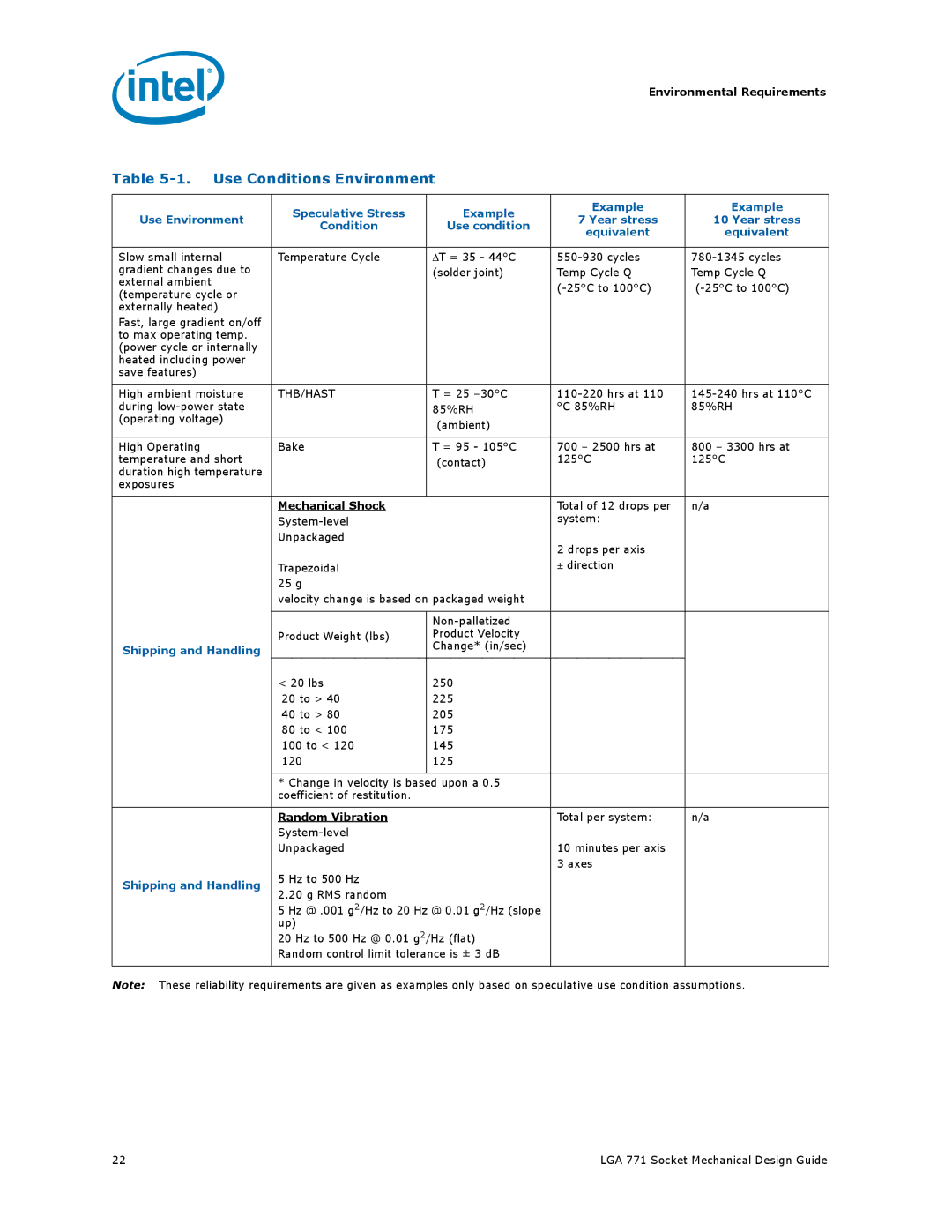
Environmental Requirements
Table | Use Conditions Environment |
|
| |||
|
|
|
|
|
| |
Use Environment | Speculative Stress | Example | Example | Example | ||
7 Year stress | 10 Year stress | |||||
Condition | Use condition | |||||
|
| equivalent | equivalent | |||
|
|
|
| |||
|
|
|
|
| ||
Slow small internal | Temperature Cycle | ΔT = 35 - 44°C | ||||
gradient changes due to |
| (solder joint) | Temp Cycle Q | Temp Cycle Q | ||
external ambient |
|
|
| |||
(temperature cycle or |
|
| ||||
|
|
|
| |||
externally heated) |
|
|
|
| ||
Fast, large gradient on/off |
|
|
|
| ||
to max operating temp. |
|
|
|
| ||
(power cycle or internally |
|
|
|
| ||
heated including power |
|
|
|
| ||
save features) |
|
|
|
|
| |
|
|
|
|
| ||
High ambient moisture | THB/HAST | T = 25 | ||||
during |
| 85%RH | °C 85%RH | 85%RH | ||
(operating voltage) |
| (ambient) |
|
| ||
|
|
|
|
| ||
|
|
|
|
|
| |
High Operating |
| Bake | T = 95 - 105°C | 700 – 2500 hrs at | 800 – 3300 hrs at | |
temperature and short |
| (contact) | 125°C | 125°C | ||
duration high temperature |
|
|
|
| ||
exposures |
|
|
|
|
| |
|
|
|
|
|
| |
|
| Mechanical Shock |
| Total of 12 drops per | n/a | |
|
|
| system: |
| ||
|
| Unpackaged |
| 2 drops per axis |
| |
|
|
|
|
| ||
|
| Trapezoidal |
| ± direction |
| |
|
| 25 g |
|
|
| |
|
| velocity change is based on packaged weight |
|
| ||
|
|
|
|
|
| |
|
|
|
|
| ||
|
| Product Weight (lbs) | Product Velocity |
|
| |
Shipping and Handling |
| Change* (in/sec) |
|
| ||
|
|
|
| |||
|
| < 20 lbs | 250 |
|
| |
|
| 20 to > 40 | 225 |
|
| |
|
| 40 to > 80 | 205 |
|
| |
|
| 80 to < 100 | 175 |
|
| |
|
| 100 to < 120 | 145 |
|
| |
|
| 120 | 125 |
|
| |
|
|
|
|
|
| |
|
| * Change in velocity is based upon a 0.5 |
|
| ||
|
| coefficient of restitution. |
|
|
| |
|
|
|
|
|
| |
|
| Random Vibration |
| Total per system: | n/a | |
|
|
|
|
| ||
|
| Unpackaged |
| 10 minutes per axis |
| |
|
|
|
| 3 axes |
| |
Shipping and Handling | 5 Hz to 500 Hz |
|
|
| ||
2.20 g RMS random |
|
|
| |||
|
|
|
|
| ||
|
| 5 Hz @ .001 g2/Hz to 20 Hz @ 0.01 g2/Hz (slope |
|
| ||
|
| up) |
|
|
| |
|
| 20 Hz to 500 Hz @ 0.01 g2/Hz (flat) |
|
| ||
|
| Random control limit tolerance is ± 3 dB |
|
| ||
|
|
|
|
| ||
Note: These reliability requirements are given as examples only based on speculative use condition assumptions. | ||||||
22 | LGA 771 Socket Mechanical Design Guide |
